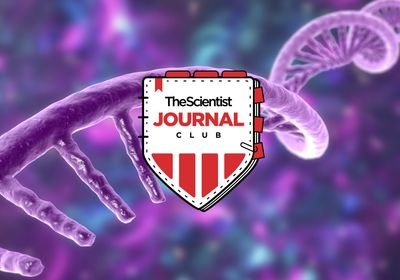ABOVE: © iStock, LightFieldStudios
Globally, an estimated 55 million people suffer from Alzheimer's disease and other forms of dementia, a number that is expected to rise steeply in the coming years.1 For decades, scientists have studied genetic contributions to risk and resilience in the context of this disease, hoping to shed light on disease processes and identify new molecular targets.
In 2019, researchers discovered a genetic quirk known as the APOE3 Christchurch mutation that seemed to protect against autosomal dominant Alzheimer's disease (ADAD), an early-onset, genetically determined form of the disease.2 Now, researchers have identified a second protective mutation: a gain-of-function mutation in RELN, the gene encoding the protein Reelin.3 Reelin plays many important roles in brain structure and function, including processes like neuronal migration and synaptic plasticity. The newly discovered RELN gene variant, which researchers named RELN-COLBOS, provides new insight into signalling pathways that may protect patients from this devastating disease.
This discovery would not have happened without the generosity of this patient
-Joseph Arboleda-Velasquez, Harvard Medical School
“This discovery would not have happened without the generosity of this patient,” said coauthor Joseph Arboleda-Velasquez, who studies neurodegenerative diseases of the brain and retina at Harvard Medical School. “It’s just amazing to see how one person committing to research can make such a huge difference.”
For many years, Arboleda-Velasquez and an international team of scientists have been studying a large cohort of related individuals in Colombia who have ADAD caused by a mutation called PSEN1-E280A. Carriers of this mutation develop mild cognitive impairment at an average age of just 44 years of age. So, when researchers learned of a man who carried this mutation but remained cognitively healthy until his late 60s, they decided to investigate further.
Neuroimaging studies performed when the man was 73 years old revealed that he had elevated levels of amyloid beta plaques in his cortex compared to other individuals with the PSEN1-E280A mutation. However, the others in this cohort were generally younger, simply because the average age of death is 59 years.4 Additionally, some areas of the man’s brain had tau tangles—aggregations of hyperphosphorylated tau proteins—that similar to other individuals in this cohort. However, his entorhinal cortex—a brain region important for memory formation and retrieval—was relatively spared, which may have accounted for the persistence of his cognitive abilities.
The researchers wondered what might explain this lack of tau pathology in certain brain regions. Genetic analysis showed that unlike the first patient, this man wasn’t protected by the APOE3 Christchurch mutation. Undeterred, researchers kept exploring and eventually discovered an unusual RELN variant in the man’s genome. “That was quite interesting,” said Arboleda-Velasquez. “Although they are different genes, RELN and APOE have some common functions.” Both gene products play a role in regulating the phosphorylation of tau.5
To explore the mechanisms by which this variant could provide protection against Alzheimer’s disease, the researchers studied the effects of RELN-COLBOS in mice. They discovered that male mice with this mutation had greater phosphorylation of Dab1, a protein involved in preventing tau hyperphosphorylation.6 Interestingly, this effect was not observed in female mice. In keeping with this sex-specific effect, the original patient had a sister who carried both the PSEN1-E280A and RELN-COLBOS mutations who was only partially protected from ADAD: She developed mild cognitive impairment at the age of 58.
Next, the researchers examined the effects of the mutation in a mouse model of tauopathy. These experiments, too, suggested protective effects. The mice displayed reduced tau phosphorylation in their hippocampi.
Arboleda-Velasquez thinks that there’s probably more to the story than just tau phosphorylation, however; several other potential protective mechanisms could still be awaiting discovery. In the brain, he said, “Reelin is a heavyweight.” Reelin plays important roles during development and in adulthood, and scientists have implicated aberrant Reelin signaling in myriad neurological and psychiatric disorders.7
Ultimately, however, Arboleda-Velasquez said, “the mechanism is not that important because this discovery is coming from people. And because it comes from people, I know two things. One is that it works. And two: it is safe.” Arboleda-Velasquez personally enjoys investigating fundamental biological mechanisms and plans to study the various ways in which this RELN variant provides protection. However, he said, it is not too early to begin exploring treatments based on these genetic findings. “The patient is telling us exactly what to do,” he said.
Steven Estus, a molecular geneticist at the University of Kentucky College of Medicine who was not involved in the study, said that based on these findings, Reelin is absolutely worth pursuing. However, because Reelin plays such an important role in brain development, it will be important to determine whether the protection provided by this mutation is a developmental effect or a late-stage effect. “That would tell you if it’s really something that is a potential treatment,” he said. While further work is needed to determine whether targeting this pathway will be effective, it highlights a promising new research avenue for a disease that desperately needs more treatment options.
References
- ADI - Dementia statistics. Available at: https://www.alzint.org/about/dementia-facts-figures/dementia-statistics/.
- Arboleda-Velasquez JF, et al. Resistance to autosomal dominant Alzheimer’s disease in an APOE3 Christchurch homozygote: a case report. Nat Med. 2019;25:1680–1683.
- Lopera F, et al. Resilience to autosomal dominant Alzheimer’s disease in a Reelin-COLBOS heterozygous man. Nat Med. 2023;29:1243–1252.
- PSEN1 E280A (Paisa) | ALZFORUM. Available at: https://www.alzforum.org/mutations/psen1-e280a-paisa.
- Hiesberger T, et al. Direct binding of Reelin to VLDL receptor and ApoE receptor 2 induces tyrosine phosphorylation of disabled-1 and modulates tau phosphorylation. Neuron. 1999;24:481–489.
- Matsuki T, et al. Identification of Stk25 as a Genetic Modifier of Tau Phosphorylation in Dab1-Mutant Mice. PLoS ONE. 2012;7:e31152.
- Jossin Y. Reelin Functions, Mechanisms of Action and Signaling Pathways During Brain Development and Maturation. Biomolecules. 2020;10:964.
This story was originally published on Drug Discovery News, the leading news magazine for scientists in pharma and biotech.







